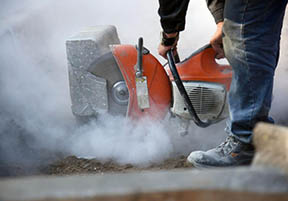
Drywall is used to form the inside walls of buildings and houses. It requires sanding, which results in a large amount of dust. Demolition of old drywall also generates a considerable amount. Drywall dust is very fine and pervasive, with a consistency close to powder. Because of this, it can quickly and easily spread throughout your home.
HAZARDS
Construction workers who sand drywall joint compound are often exposed to high concentrations of dusts and, in some cases, respirable silica. Drywall joint compounds are made from many ingredients (i.e., talc, calcite, mica, gypsum, silica). Some of these have been associated with varying degrees of eye, nose, throat, and respiratory tract irritation. Over time, breathing the dust from drywall joint compounds may cause persistent throat and airway irritation, coughing, phlegm production, and breathing difficulties that are similar to asthma. Smokers or workers with sinus or respiratory conditions may risk even worse health problems. When silica is present, workers may also face an increased risk of silicosis and lung cancer.
CONTROLS
A recent NIOSH Health Hazard Evaluation (HHE) found that drywall sanders were exposed to as much as 10 times the permissible exposure limit (PEL) of 15 mg/m3 for total dust set by the Occupational Safety and Health Administration (OSHA). The OSHA PEL for respirable dust (5 mg/m3), the very small particles that can go deep into the lungs, was also exceeded.
Drywall joint compound manufacturers recognize that workers might be exposed to too much dust during drywall sanding. NIOSH studied five manufacturers material safety data sheets (MSDSs) that warned workers to avoid generating dust and to use respiratory protection when dry sanding. Four of the MSDSs told construction workers to use wet sanding whenever possible, and the fifth said to cut dust exposures by ventilation. However, these guidelines are seldom followed in actual work practice. Wet sanding is generally avoided because of concerns about drying time and finish texture. Wet sanding is used to protect equipment or furnishings rather than to reduce work exposures.
